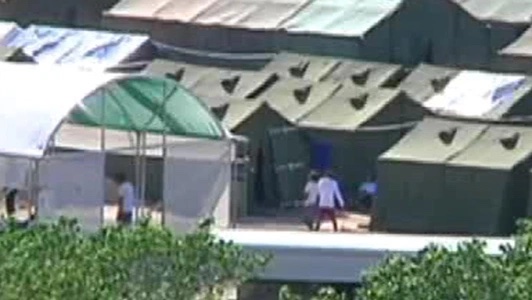
A key plank of Australia’s asylum policy is deterrence. What happened to asylum being the key plank of asylum policy? Deterrence in this instance means “offshore camps”, particularly on the islands of Manus and Nauru Islands. Manus Island is part of Papua New Guinea, where a trial opened today to challenge the legality of the “processing camps”. The charge is that the Papua New Guinean law does not allow for detention without any charge. Detention camps. Processing camps. Or, as Marianne Evers said of the camp on Nauru, “I actually liken it to a concentration camp.” Not surprisingly, the Australian government takes offense at the likening, “I think invoking concentration camp is a disgrace.” Calling the camps on Manus Island and Nauru Island “concentration camps” is a disgrace, but the camps themselves … are fine?
No.
Last week, New Matilda published three sets of letters by women asylum seekers currently imprisoned on Manus Island. The women are from Iran, Pakistan, Sri Lanka, Afghanistan. They describe terrible hardships in their homelands, terrific struggles to get to Australia, and then debilitating, crushing conditions on Christmas Island and then on Manus Island. They describe the dire mental health crisis that sweeps through the camps, especially among the younger men who are increasingly suicidal. They write about their struggle for safety for themselves and their children. They write a great deal about their children. They describe the life draining out of their children within the universe of trauma that constitutes the detention camp. They describe the cultures and public policies of violence against women in their homelands that compelled them to leave, to seek personal safety and dignity.
The United Nations Refugee Agency, UNHCR, issued a report last week on Manus Island, based on a January visit. The agency confirms the reports of the women asylum seekers. The physical conditions are “harsh”. The living quarters have no privacy, which is a particular concern to parents of girls; are unbearably hot; and have grossly inadequate sanitary facilities. And that’s the family compound. The conditions in the compound for single male adults are worse.
The conditions are generally and specifically traumatic. They breed mental health crises on an individual, collective and structural basis. For the adults, it’s terrible. For the children, it’s crushing.
The UN list of dehumanizing conditions goes on, but here’s the point. This is what happens when deterrence is a key plank in asylum policy. Since Australia began “offshore processing” its asylum seekers, have the numbers gone down? Absolutely not. They’ve risen, incrementally. Does that mean the policy hasn’t worked? According to the State, it means the State hasn’t arrived at the proper balance of harsh and brutal. When the Australian government can match the brutality the women, children and men have fled, then it will have arrived at what it considers to be an appropriate asylum program.
Australia has invested political capital, national identity, and hard cold cash in brutalizing asylum seekers. They have sought partners. First they turned to Papua New Guinea, and this week, they turned to New Zealand. Australia sees asylum seekers as another `opportunity’ for regional free trade agreements. This time trade is in battered bodies and dreams.
Why can’t asylum, rather than deterrence, by the key plank of the asylum policy? What would it take to move the concept of the right to asylum to the center of all asylum policy? Ask the women asylum seekers on Manus Island. Repeatedly, they say they fled violence but they sought peace. Peace, rather than `security’, must govern asylum policy.
Meanwhile, the women who sought peace sit in the harsh camps on the remote islands, look at their children, look at themselves, look at the guards, look at where they’ve come to and where they’re probably going, if the State has its way, and they sigh, “O brave new world, that has such people in’t.”
(Photo Credit: Al Jazeera)